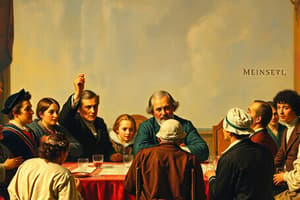Podcast
Questions and Answers
How does the House of Representatives enhance the principle of majority rule in executive governments?
How does the House of Representatives enhance the principle of majority rule in executive governments?
The House of Representatives enhances majority rule by having absolute majorities behind every member, leading to more representative executive governments.
What opportunities do minor parties gain in a majority rule system regarding preference deals?
What opportunities do minor parties gain in a majority rule system regarding preference deals?
Minor parties gain opportunities to trade preferences and make policy deals with major parties, which can increase their fairness in the political process.
What is the primary objective of proportional representation (PR) systems?
What is the primary objective of proportional representation (PR) systems?
The primary objective of PR systems is to allocate seats in parliament in proportion to the total votes a party receives.
How do proportional representation systems promote diversity in parliamentary representation?
How do proportional representation systems promote diversity in parliamentary representation?
What characterizes the Single Transferable Vote (STV) proportional representation system?
What characterizes the Single Transferable Vote (STV) proportional representation system?
How does the concept of a quota in STV/PR differ from a simple majority in elections?
How does the concept of a quota in STV/PR differ from a simple majority in elections?
What is the significance of surplus votes in the STV system?
What is the significance of surplus votes in the STV system?
Why do STV/PR elections allow for multiple candidates from different parties to represent the same electorate?
Why do STV/PR elections allow for multiple candidates from different parties to represent the same electorate?
What impact does the lower quota have on minor political parties during elections?
What impact does the lower quota have on minor political parties during elections?
In terms of representation, what advantage does STV/PR provide compared to traditional electoral systems?
In terms of representation, what advantage does STV/PR provide compared to traditional electoral systems?
Flashcards are hidden until you start studying
Study Notes
House of Representatives and Executive Government
- The House of Representatives formed more representative executive governments by enhancing majority rule.
- Minor parties gained slight fairness through opportunities for preference trading and policy deals.
- Loss of parties cannot enforce preference deals in parliament, as they are more like promises than contracts.
- Minor party voters can hold major parties accountable in subsequent elections.
Proportional Representation Systems
- Proportional Representation (PR) systems allocate seats in parliament in accordance with the percentage of votes received.
- For instance, a party with 30% of the vote would receive 30% of the seats.
- Majoritarian systems operate on a ‘winner takes all’ principle, while PR systems ensure parties receive seats proportional to their votes.
Single Transferable Vote (STV)
- STV/PR requires a quota, not a majority, to win a seat; one quota per seat across multi-member electorates.
- Electors rank candidates or parties in order of preference, distributing surplus votes until all quotas are filled.
- Quotas for various electorates differ significantly; NSW's quota is roughly 350,000 compared to 20,000 in Tasmania.
Advantages of STV/PR
- Fairer representation for electors and parties; any candidate achieving a quota can win.
- In federal Senate elections, a quota approximates 14.3% of formal votes; during double dissolution, this quota is halved.
- STV/PR leads to a Senate that better mirrors societal diversity and enhances mirror representation.
Challenges with STV/PR
- Voters face difficulties in identifying representatives, as multiple candidates represent the same electorate.
- Initial STV/PR implementation required electors to number every candidate on the ballot, leading to many informal votes.
Group Ticket Voting and Preference Trading
- Group ticket voting enabled parties to pre-register candidate lists and dictate preference allocation for electors.
- Above-the-line voting offers simpler party-based choices, while below-the-line voting involves complex preference numbering.
- This system obscured candidate identities and allowed inter-party preference trading, risking democratic integrity.
2016 Electoral Reforms
- The Commonwealth Electoral Amendment Act 2016 abolished group ticket voting and strengthened electorate control over preferences.
- Electors can vote above the line for parties or below for candidates with increased control over their preferences.
- Introduced political party logos on ballots to reduce electoral confusion.
Calculating Quotas and Counting Votes
- Senate quotas are calculated by dividing the number of formal ballot papers by the number of seats plus one.
- Surplus votes are determined by subtracting the quota from total votes received by elected candidates.
Compulsory Voting Advantages
- Compulsory voting leads to higher voter turnout, boosting political participation.
- Increases understanding of democratic principles and strengthens the legitimacy of parliamentary decisions.
- Drowns out extreme political ideologies and promotes moderate discourse among competitive parties.
Compulsory Voting Disadvantages
- May lead to uninformed or disengaged voters, resulting in donkey votes and increased informal ballots.
- Some libertarians argue that enforcing voting infringes on personal rights.
Studying That Suits You
Use AI to generate personalized quizzes and flashcards to suit your learning preferences.




